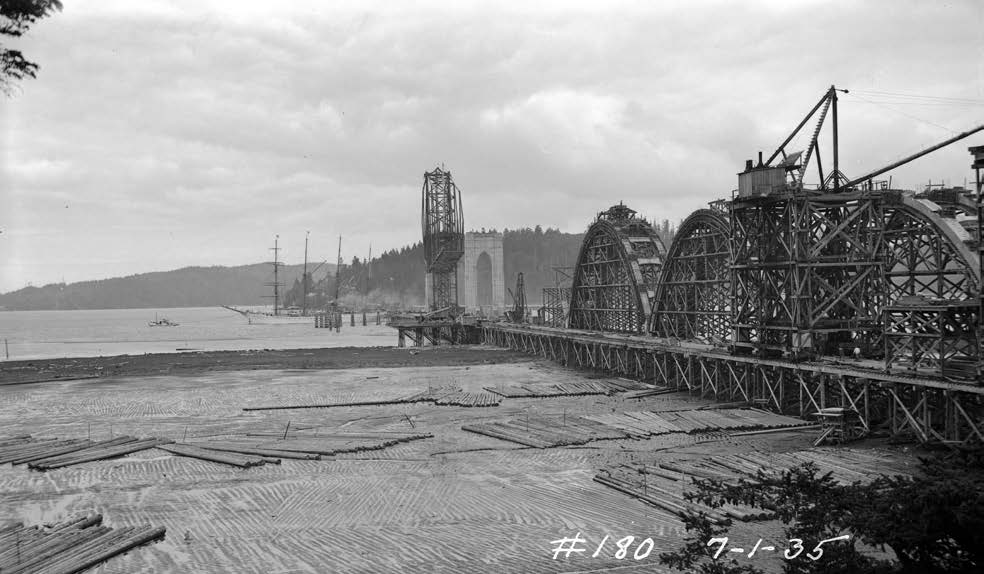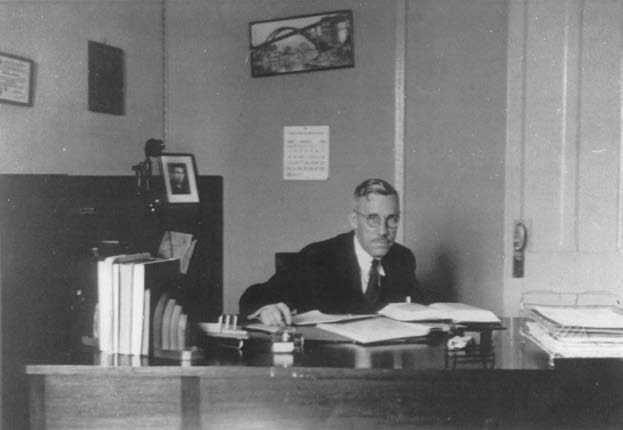We Recommend:
Bach Steel - Experts at historic truss bridge restoration.
BridgeHunter.com Phase 1 is released to the public! - Visit Now
Conde B. McCullough Memorial Bridge
Coos Bay Bridge

Primary Photographer(s): Nathan Holth
Bridge Documented: September 1, 2018
North Bend: Coos County, Oregon: United States
Metal Cantilever 26 Panel Rivet-Connected Through Truss, Fixed and Approach Spans: Concrete Open Spandrel Deck Arch, Fixed
1936 By Builder/Contractor: Virginia Bridge and Iron Company of Roanoke, Virginia and American Bridge Company of New York, New York and Engineer/Design: Conde Balcom McCullough (Oregon State Highway Commission)
2018
793.0 Feet (241.7 Meters)
5,323.0 Feet (1622.5 Meters)
27 Feet (8.23 Meters)
3 Main Span(s) and 27 Approach Span(s)
1823

View Information About HSR Ratings
Bridge Documentation
Latest news about this bridge: As of 2018, this bridge had received an extensive rehabilitation of its concrete arch spans. In 2019, a three year project to repaint the bridge will take place.
View Archived National Bridge Inventory Report - Has Additional Details and Evaluation
View Historic American Engineering Record (HAER) Documentation For This Bridge
HAER Data Pages, PDF
View Historical Article About This Bridge
View Historic Bridge Inventory Sheet For This Bridge
View National Register of Historic Places Nomination Form For This Bridge
HAER Documentation, Oregon Coast Highway Bridges - Data Pages - Drawings
The Oregon Coast Highway is the name given to US-101 as it follows the Pacific coastline in Oregon. This highway is significant for its numerous historic bridges, including a number of unique design. Also noteworthy is the effort made to preserve and maintain these unique bridges, many of which are very impressive structures designed by noted engineer Conde McCullough.
The 1936 Conde B. McCullough Memorial Bridge over Coos Bay was named after the engineer who designed this and so many of the Oregon Coast Highway Bridges. One of the most significant bridges in Oregon, this unique bridge consists of numerous open spandrel concrete arch approach spans and a steel riveted cantilever through truss for the main spans. McCullough was a strong supporter of concrete bridges, and often resorted to use of steel only when the crossing needs dictated it. That said, McCullough's approach to steel bridge construction is both unique and impressive. Despite being built in a time where bridges often had built-up beams with lacing and lattice on the members, this bridge was built of solid steel members, drawing the eye to the appearance of the bridge as a whole, rather than detailed built-up parts of the bridge. Where built-up members were used, cover plate was pierced with diamond-shaped handholes, a unique and more attractive approach to the oval-shaped handholes which started to be used in bridge construction in the late 1930s. The top and bottom chords of the truss offer an unusually curve-like and graceful appearance that differs from typical cantilever truss bridges. The portal bracing for the bridge is a work of art in its own right, with a unique and highly decorative design. The abutments of the bridge include beautiful stairways for pedestrian traffic.
Virginia Bridge and Iron Company of Roanoke, Virginia was the general contractor for the bridge. The American Bridge Company of New York fabricated the steel for the bridge. Assisting Conde B. McCullough in the design of the bridge was Dexter R. Smith, a design engineer for the approach spans and Raymond Archibald, a design engineer for the truss spans. The cantilever truss spans total 1,708 feet in length, including two 457.5 foot anchor spans and the central span of 793 feet. The truss arrangement of the bridge is unusual in that some of the truss panels follow a Baltimore style truss configuration, while other panels follow a Pratt-like configuration.
Thanks to McCullough, this bridge is a unique design which has no equal in Oregon or anywhere else.
Above: Conde McCullough
Above: Historical photo showing construction of the truss spans showing a segment of the top chord being moved into place.
Above: Historical photo showing construction truss spans, with the cantilever arm erection in progress.
Above: Historical photo showing construction of the arch spans, with the arch centering visible to the right.
Above: Historical photo showing construction of the arch spans. Here, the span shown has had the centering removed.
Above: Historical photo showing bridge construction.
Above: Conde McCullough
![]()
Photo Galleries and Videos: Conde B. McCullough Memorial Bridge
Overview and General Details
Original / Full Size PhotosA collection of overview photos that show the bridge as a whole and general areas of the bridge, and general details of the bridge. This gallery offers photos in the highest available resolution and file size in a touch-friendly popup viewer.
Alternatively, Browse Without Using Viewer
![]()
Truss Details
Original / Full Size PhotosA collection of detail photos that document the parts, construction, and condition of the truss spans of this bridge. This gallery offers photos in the highest available resolution and file size in a touch-friendly popup viewer.
Alternatively, Browse Without Using Viewer
![]()
Overview and General Details
Mobile Optimized PhotosA collection of overview photos that show the bridge as a whole and general areas of the bridge, and general details of the bridge. This gallery features data-friendly, fast-loading photos in a touch-friendly popup viewer.
Alternatively, Browse Without Using Viewer
![]()
Truss Details
Mobile Optimized PhotosA collection of detail photos that document the parts, construction, and condition of the truss spans of this bridge. This gallery features data-friendly, fast-loading photos in a touch-friendly popup viewer.
Alternatively, Browse Without Using Viewer
![]()
Conde McCullough Documentary
Full Motion VideoProduced by Oregon Department of Transportation, this is a short seven minute documentary about Conde McCullough. Streaming video of the bridge. Also includes a higher quality downloadable video for greater clarity or offline viewing.
![]()
Maps and Links: Conde B. McCullough Memorial Bridge
Coordinates (Latitude, Longitude):
Search For Additional Bridge Listings:
Bridgehunter.com: View listed bridges within 0.5 miles (0.8 kilometers) of this bridge.
Bridgehunter.com: View listed bridges within 10 miles (16 kilometers) of this bridge.
Additional Maps:
Google Streetview (If Available)
GeoHack (Additional Links and Coordinates)
Apple Maps (Via DuckDuckGo Search)
Apple Maps (Apple devices only)
Android: Open Location In Your Map or GPS App
Flickr Gallery (Find Nearby Photos)
Wikimedia Commons (Find Nearby Photos)
Directions Via Sygic For Android
Directions Via Sygic For iOS and Android Dolphin Browser
USGS National Map (United States Only)
Historical USGS Topo Maps (United States Only)
Historic Aerials (United States Only)
CalTopo Maps (United States Only)











